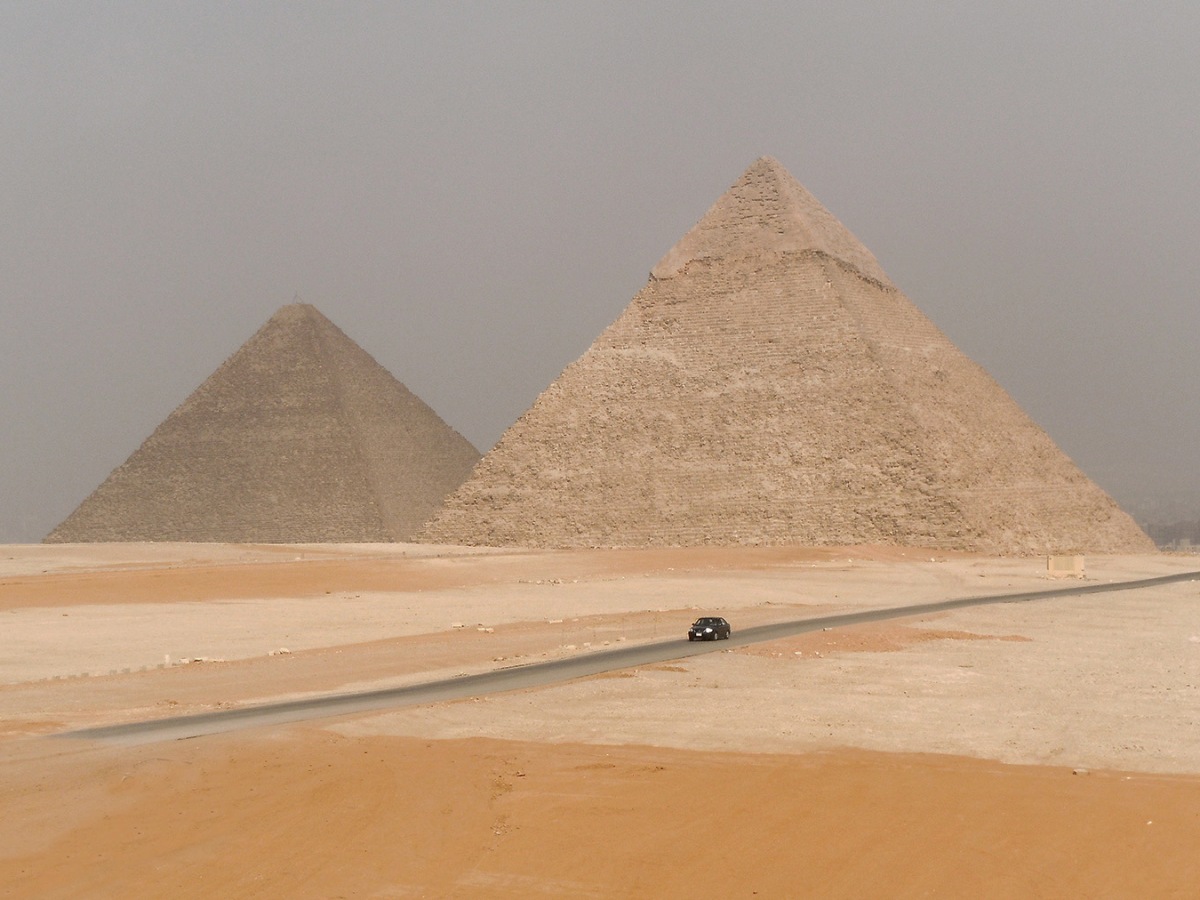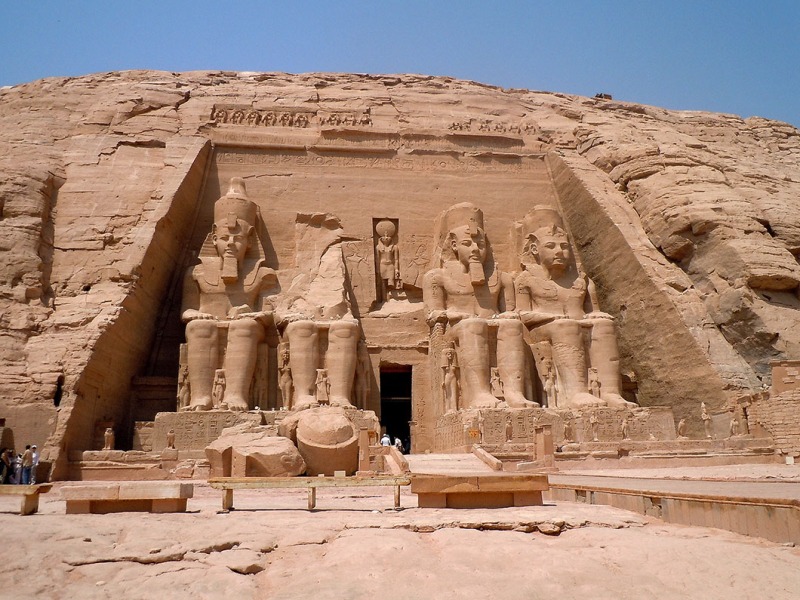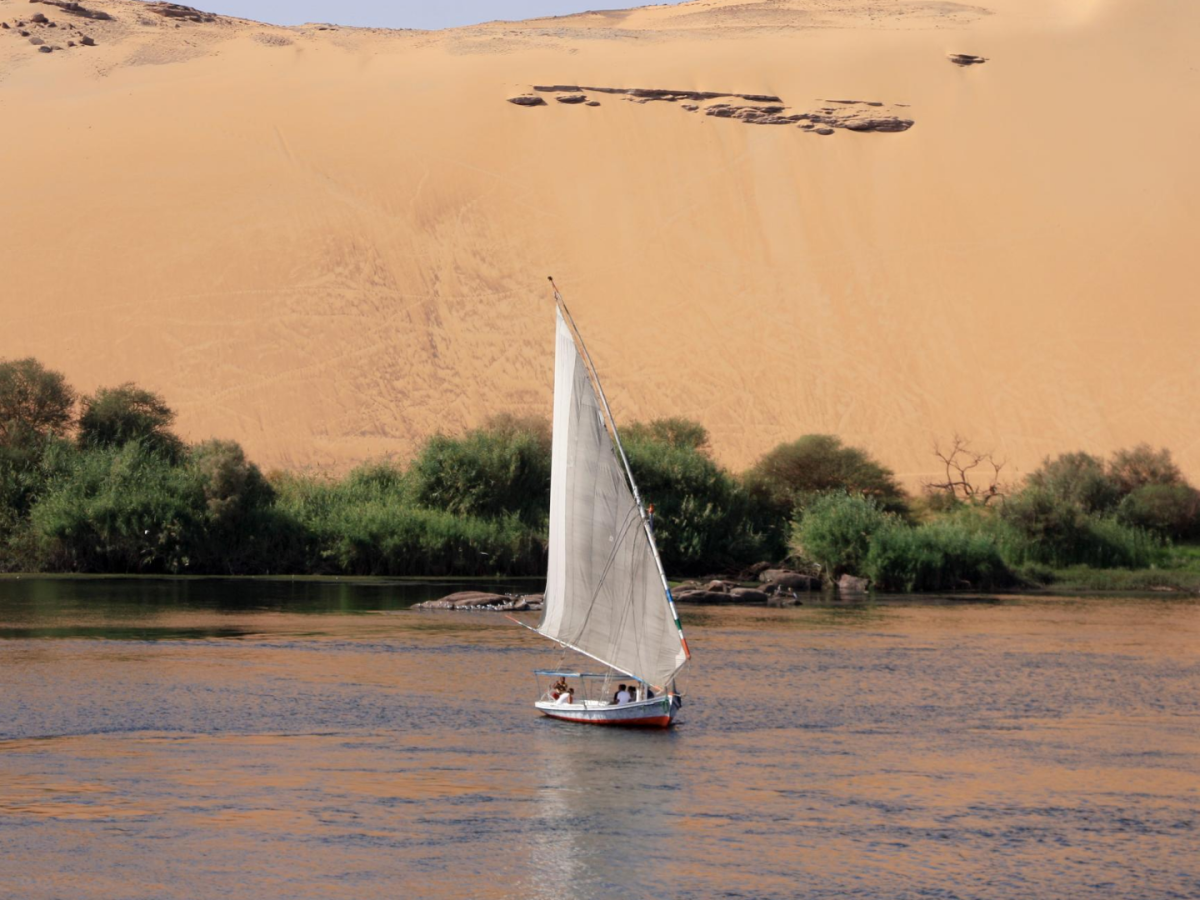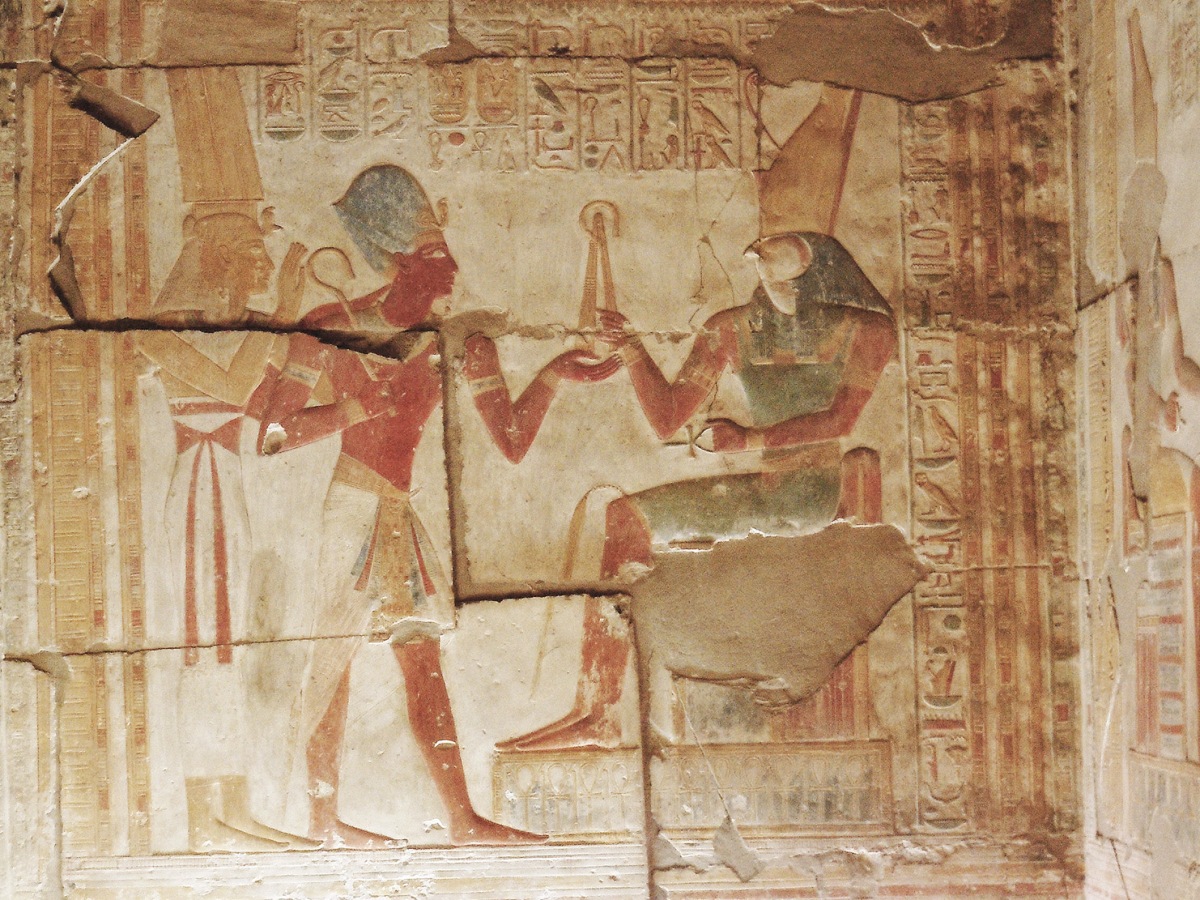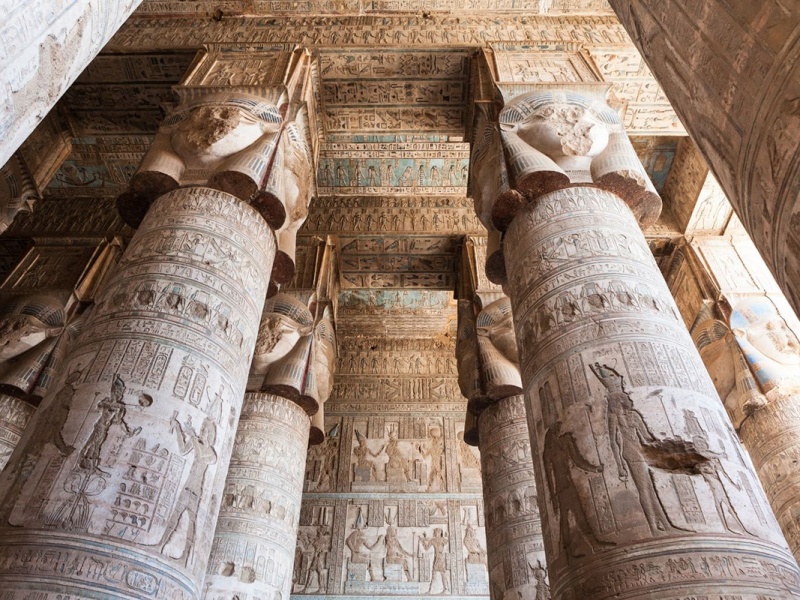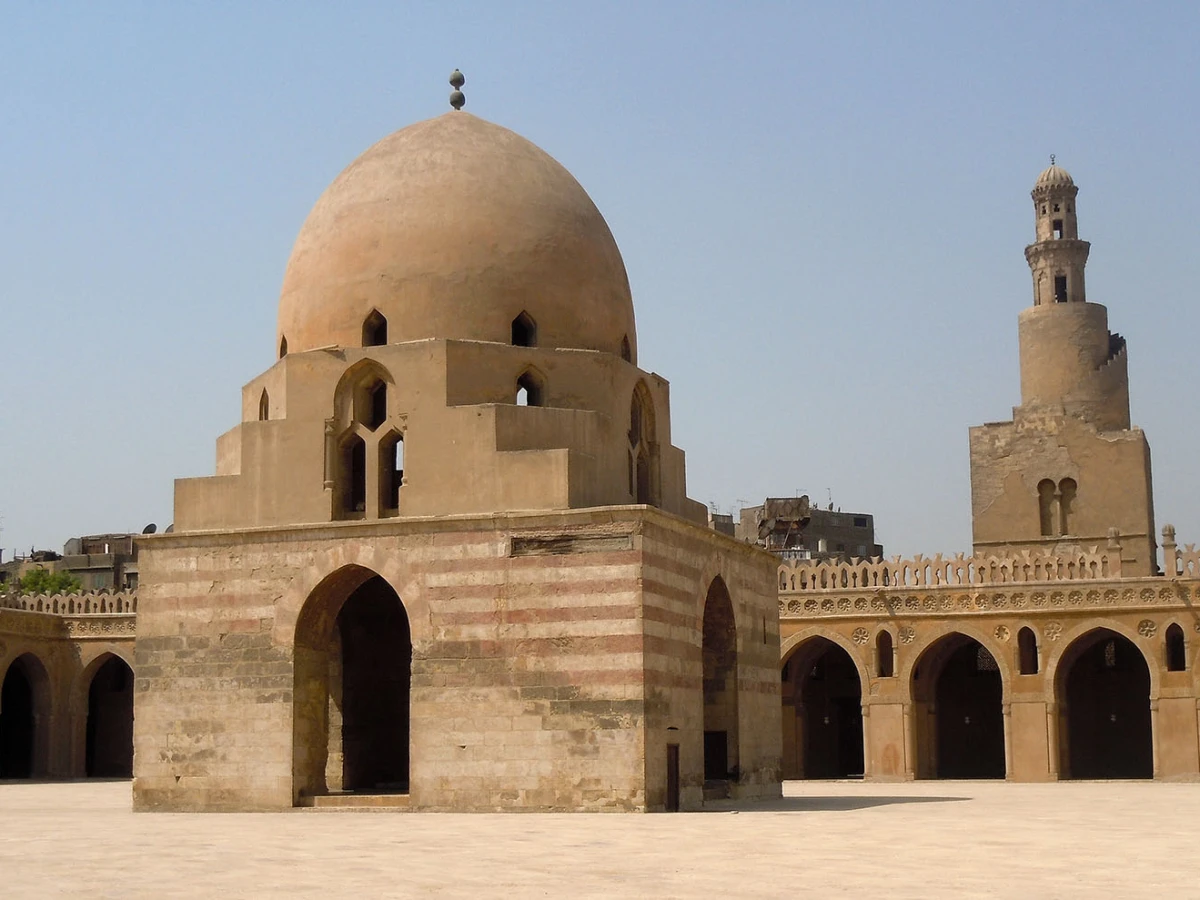
EPIC TEN DAY JOURNEY THROUGH EGYPT
UPDATED DECEMBER 2022
Egypt gives ‘ancient’ a whole new meaning.
That the average age of listed monuments in this amazing country is well over 2000 years is astounding enough. That the remarkable Egyptian civilisation achieved such an extraordinary degree of finesse in its art and everyday life boggles the mind.
Add a considerable concentration of early Christian and medieval Islamic monuments along with a legendary river meandering through it all and you have one of the most culturally fascinating destinations on this planet.
What are the places to visit in Egypt? This 10-day Egypt itinerary covers much of the highlights and everything you need to know before you go.
We’ll explore a number of Egyptian pyramids besides the lone surviving ancient wonder of the world, the most iconic temples and tombs and the dazzling treasures meant for the afterlife of a Boy King. We finish in the medieval alleys and age old souks of the capital, in the shadow of its thousand minarets.
Also, find all your questions about the Cairo Pass, Luxor Pass and Nile Cruise answered.
Is Egypt safe to travel to? Yes! Safety is not a concern in the areas frequented by tourists. You’ll find a lot more details along with all the information on visas, logistics and resources you’ll ever need to plan a perfect trip in my – fully updated – Egypt Travel Guide.

EGYPT TRAVEL GUIDE
Complete travel guide with tips on Cairo Pass, Luxor Pass, Nile Cruise, best places to stay, detailed Egypt itinerary and more.
PLEASE NOTE – This post contains affiliate links. If you buy something following a link on this page I’ll receive a small commission at no extra cost to you. Your support is much appreciated.

TEN DAY EGYPT ITINERARY
2 DAYS/3 NIGHTS IN GIZA
Being awed by iconic pyramids, exploring Old Kingdom tombs in the Saqqara necropolis and admiring Tutankhamen’s treasures
2 DAYS /2 NIGHTS IN ASWAN
Soaking in Nubian culture and a detour to the Temples of ABU SIMBEL
4 DAYS /3 NIGHTS IN LUXOR
Visiting the extraordinarily decorated tombs of the West Bank & the incredible KARNAK, LUXOR, ABYDOS & DENDERA temples
1+ DAYS/ 2 NIGHTS IN CAIRO
Diving into the historic heart of Cairo.
START
Arrive in Cairo and check into your Giza hotel.
Most flights into Cairo land too late for any significant sightseeing. Immigration and baggage claim aren’t quite the quickest in the world and traffic can be pretty chaotic.
In case you arrive early and jet lag is not an issue, you could bring the itinerary forward and save a day.
Should you stay in Giza or downtown Cairo? That’s a much debated question. I personally prefer clubbing the entire Cairo portion at the end in a downtown hotel. But that’s because I’m a downtown person and like exploring cities. We did regret not having stayed in the Mena house and woken up to pyramid views on our last trip though. A little.
Read more in my notes at the end about the construction of this itinerary to help you make up your mind.
WHERE TO STAY: Marriott Mena House
WHERE TO EAT: If you are arriving late you are probably better off dining in your hotel or requesting room service.
Lunch: Felfela | Koshary Hakkaya | 139 Restaurant (Mena House)
Dinner: Andrea (Egyptian. 30 min by road.) | Restaurants in the Marriott Mena House/Le Meridien Pyramids Hotels.
DAY 1 – THE PYRAMIDS OF GIZA, THE SPHINX AND THE EGYPTIAN MUSEUM
MORNING: Be awed on your first morning by the scale of the pyramids. Try to be at the pyramids as soon as they open to avoid tour group crowds that typically begin arriving around 09.30. And try to ignore the touts.
Start at the East gate near the Sphinx if you want it almost to yourself in the morning light. The (not too long) walk towards the pyramids is uphill from here. If you have a private car/taxi at your disposal they’ll be able to drive you to the closest parking lots within the complex and to the panorama points.
If not, and walking uphill is an issue, then start at the main northern entrance, explore the pyramids and the panorama points and then make your way downhill towards the Sphinx and the Valley Temple and exit by the East Gate.
Time on site: approximately 3-4 hours including pyramid entry. More details about navigating the Giza plateau in the featured posts below.
You certainly should not miss the Solar Boat (Khufu’s Boat) Museum nearby.*
* Update Oct 2023: The Great Pyramid is closed to the public. Menkaure’s Pyramid has been opened instead. No details yet about numbers being allowed in. Tips for pyramid entry below apply to all pyramids.
* There’s been a move toward cashless entry for individual tickets. All entrance fees to Cairo & Luxor monuments are to be paid with a credit or debit card only. Cards will be charged in LE. Find current prices and opening hours here (remember to click on the ‘other nationality’ tab).
* Update Sept 2022: The Solar Boat has been moved to the Grand Egyptian Museum and the building it was housed in has been demolished.
*Update April 2023: The Egyptian Museum in Tahrir – also known as the Old Egyptian Museum – will extend its opening hours from 9am to 7pm (instead of 5pm) starting Friday, 21 April. The opening hours of the Giza Plateau will be from 7am to 6pm, instead of 5pm, starting 01 May, 2023
NOTE ON PYRAMID ENTRY: Entry numbers to the Great Pyramid are limited to 300 per day. Be aware that you’ll need to be fairly fit to navigate the narrow, airless tunnel in which you’ll be bent over for long stretches. Also, the interiors of all the major pyramids are empty chambers with little to no decoration.
Pyramids Of Egypt – Facts, Myths & Practical Tips
Optimise your visit to the Pyramids of Giza, Dahshur & Saqqara with this useful guide filled with amazing facts and practical tips.
Read MoreEgypt – Khufu’s Boat Museum In Giza
The Solar Boat Museum in Giza is dedicated to the Khufu Ship. Read all about the only surviving ancient Egyptian Solar Boat and the best way to see it.
Read MoreAFTERNOON:
The Egyptian Antiquities Museum will likely (hopefully!) have moved to its swank new premises in Giza by the time post-pandemic travel picks up significantly. 7000sq metres of the 500,000 sq metre space in its re-incarnation as the Grand Egyptian Museum will be dedicated to the treasures of Tutankhamen.
If there’s been yet another delay, take a taxi into Cairo city to its present location on Tahrir Square. Around 14.00 is a good time to visit when the worst of the crowds are away at lunch. Or make use of the late opening hours on Sundays & Thursdays. Visiting the highlights takes a couple of hours on average.
If you are done with the museum early you could catch the Sound & Light show. The Pizza Hut opposite the eastern gate is a great place to watch it from for the price of a pizza dinner.

GETTING THERE: The Pyramid entrance is minutes from the Mena House. The east gate is about a 15 min. walk away. You could hire a taxi to avoid hassle along the way and get the driver to wait for you there or at the parking lot at the pyramid entrance…remember not to pay in advance.
EGYPTIAN MUSEUM (in its current location.)
HOURS: Mon – Wed: 09.00 to 17.00. Fri & Sat: 09.00-19.00. On Thu & Sun: 09.00-17.00 & 19.30-21.00.
TICKETS: Adult: EGP 160\ Student: EGP 80 | Inclusive Ticket (Entry+ Mummies Hall) : Adult: EGP 300\ Student: EGP 150
CAMERA Fees have been scrapped. Tripods might still attract a nominal fee.
GIZA PLATEAU:
HOURS: Open daily Oct -Mar 08.00-17.00 | Apr – Sept 07.00- 17.00.
TICKETS: Area entry only: Adult: EGP 200 / Student: EGP 100All inclusive (Area entry + The Great Pyramid + Khufu’s Boat Museum): Adult: EGP 600 / Student: EGP 300
Sphinx Zone: Adult: EGP 100; Student: EGP 50; Meres-Ankh Tomb: Adult: EGP 50; Student: EGP 25; Solar Boat Museum: EGP 100 / Student: EGP 50
Camera fees have been scrapped. Tripods might still attract a nominal fee.
Individual tickets are only sold at the main (Mena House) gate. The Sphinx Gate counter only sells general area tickets.
DAY 2 – SAQQARA, MEMPHIS & DAHSHUR
Our first stop today is Dahshur where Pharaoh Snofru began the transition to smooth sided pyramids. First, with the Bent Pyramid, whose angle needed to be changed mid-construction to prevent it’s collapse. Snofru’s second and successful attempt, the Red Pyramid, is the third largest in Egypt.
The 4600 year old Step Pyramid of Djoser in Saqqara is the oldest and considered the first ever monumental stone construction. Until then all tombs were flat roofed square structures called Mastabas. Most were extensively decorated.
You should be able to include the Imhotep Museum, the Pyramid of Teti or Unas and two to four of the Mastabas in about 2+ hours. The most notable mastabas are those of Ti, Mereruka, Plahotep and Kagemni. The Pyramid of Unas sometimes closes by noon. Confirm timings at the counter and head there first.
Photography wasn’t permitted during our visit. It is now. Here’s a virtual walkthrough of the Unas Pyramid.
Stop at Memphis on the way back if you wish (we didn’t.) The highlights in the capital of the Old kingdom, now mostly in ruins, is a monumental ten meter long fallen statue of Ramesses II and a sphinx carved out of a single block of alabaster.
A Cairo Pass gives you access to all these sites. More details at the end of this itinerary.
CAN YOU VISIT DAHSHUR, SAQQARA AND THE GIZA PYRAMIDS IN ONE DAY?
Technically yes, if you can be in Dahshur by 8.00 and can enter the Giza Plateaux by 14.00 you’ll still get 3 hours on the site. It’s the worst time of day to be out in the desert sun, however, and tickets to enter the Great Pyramid might be sold out. If you decide to do it, I recommend skipping Memphis. Keep in mid that last entry to the Giza Complex is at 16.00.

GETTING THERE
TRAVEL TIME: Total 3 hrs. Just under an hour each way from Giza; 30 min between Dahshur & Saqqara; 20 min from Saqqara to Memphis.
TIME ON SITE: Allow one hour to explore Dahshur and 2+ hrs for Saqqara depending on how many tombs you decide to visit. Memphis is doable in well under an hour.
HOURS: Open daily Oct -Mar 08.00-17.00 | Apr – Sept 07.00- 19.00.
CAMERA Fees have been scrapped. Tripods might still attract a nominal fee.
TICKETS:
DAHSHUR: EGP 60 / Student: EGP 30
MEMPHIS: Adult: EGP 80 / Student: EGP 4
Parking: EGP 10
SAQQARA
Standard Ticket for Saqqara Area & Imhotep Museum: Adult: EGP 180 / Student: EGP 90
Nobles Tombs & New Kingdom Cemetery: Adult: EGP 140 / Student: EGP 70
Tomb of Mereruka: Adult: EGP 80 / Student: EGP 40
Serapeum: Adult: EGP 150 / Student: EGP 75
Pyramid of Djoser: Adult: EGP 100 / Student: EGP 50
Southern Tomb in Djoser Complex: Adult: EGP 100 / Student: EGP 50
All Inclusive Ticket: (Saqqara Area, Imhotep Museum, Nobles Tombs, New Kingdom Tombs, Serapeum, Tomb of Mereruka, Tomb of Mehu.): Adult: EGP 400 / Student: EGP 220
✦ The Pyramid of Unas sometimes closes by noon. Confirm timings at the counter and head there first.
DAY 3 – FLY FROM CAIRO TO ASWAN. PHILAE TEMPLE, SOUK AND A SUNSET FELUCCA RIDE ON THE NILE
Aswan feels idyllic after chaotic Cairo.
The Temple of Isis, rescued from the rising waters of the Aswan High Dam and relocated stone by numbered stone from the island of Philae to the island of Agilkia, is the main agenda for this morning. It was the seat of the isis Cult and was one of the last ancient Egyptian temples to remain active until Emperor Justinian’s ban on pagan places of worship in 553AD.
Next, grab a table at one of the riverside restaurants for a slow meal with a view. Then head over to the Nubian Museum if you’d like some wonderful insights into local history and culture. It’s a beautifully designed building in a great setting.
A dreamy felucca ride on the Nile just before sunset is an experience not to be missed. Shell out for a private boat, you will not regret it.
For more interesting things to do in Aswan (with more time) check out my Nubian Landscapes post featured below.
WHERE TO STAY: Sofitel Legend Old Cataract | Movenpick Resort & Spa
WHERE TO EAT: Al Dokka (River views.) | Soleih Nubian (On Bigeh Island with Philae temple views. Best combined with temple visit.) | The Terrace at the Sofitel Legend Old Cataract (River views. Reservation recommended. Formal attire mandatory for the 1902 restaurant.) | Panorama Restaurant & Bar and Mezze at the Movenpick Resort (Elephantine Island) | Nubian Dreams (Elephantine Island)

Getting Around: Cheap ferries between islands. Ferries to and from hotels are free and ply until late on request.
GETTING TO PHILAE TEMPLE:
The only way to get to the island is by boat from the closest pier. Approximate price: EGP 200 per boat (4-6 persons) depending on your haggling skills. Factor in taxi ride from your hotel.
TIP: Finalise boat price BEFORE buying temple tickets (Counter is before the pier) or your negotiation might not be very effective. And remember to only pay after your return. With just one full day, I recommend pre-arranging transport with a tour company. Include airport pick-up, all excursions and transfer to Luxor.
PHILAE TEMPLE
HOURS: June to Sept: 07.00- 17.00; Oct to May: 07.00-16.00
TICKETS: Adult: EGP 180 / Student: EGP 90
CAMERA Fees have been scrapped. Tripods might still attract a nominal fee.
NUBIAN MUSEUM
HOURS: June to Sept: 07.00- 17.00; Oct to May: 07.00-16.00
TICKETS: Adult: EGP 140 / Student: EGP 70
CAMERA Fees have been scrapped. Tripods might still attract a nominal fee.
FELUCCA RIDE: Approx. EGP 150 per hour (for boat not per person.)
SOUND & LIGHT SHOW: EGP 45 No discounted tickets
DAY 4 – DAY-TRIP TO ABU SIMBEL
The Abu Simbel temples have got to be among the most emblematic of ancient Egyptian monuments, second only to the Pyramids of Giza. The rock cut temple with colossal statues of Ramesses II, and beside it the only temple in all of Egypt in honour of a queen consort are both unmissable. The remarkable feat of their rescue from being submerged beneath the waters of the Aswan High Dam add much to their appeal. More details about visiting Abu Simbel in my post linked to below.
Options for the afternoon are: a walk around Elephantine island with its local villages and the ancient archaeological site of Abu, a boat ride to Sehel island to check out ancient rock inscriptions, take a ferry across to the Nobles tombs on the west bank or while away some time in the botanical gardens on Kitchner’s Island. You could also catch a sound & light show at the Philae temple if interested. The timing is staggered based on language. Pick a suitable timing from this schedule.
Egypt – The Twin Temples Of Abu Simbel
Complete guide to the Abu Simbel Egypt Temples with tips on how to get there, facts, history and travel tips to help you plan your visit.
Read MoreNubian Landscapes – Best Things To Do In Aswan, Egypt
What to see and do in Aswan, Egypt and how best to experience the Nubian city and its beautiful landscape.
Read MoreGETTING THERE: There are multiple ways to get there: By flight; by road and by boat. More details in post above.
TICKETS: Adult: EGP 240/ Student: EGP 120; February 22nd & October 22nd: Adult: EGP 500/ Student: EGP 250
CAMERA Fees have been scrapped. Tripods might still attract a nominal fee.
DAY 5 – VISIT KOM OMBO, EDFU & ESNA ON THE WAY TO LUXOR
Depart for Luxor today on the scenic east bank road. A direct transfer normally takes under 4 hours. But the three Ptolemaic temple stops on the way add a good 4- 5 hrs to the journey. The driving time between each stop is about an hour to an hour and a half.
The temple of Kom Ombo is a twin temple with extensive mural reliefs right from the outer wall. One temple is dedicated to Sobek the crocodile headed God of fertility and the other to the falcon headed Haroeris (Horus the elder, brother of Osiris. Not to be confused with Horus the son of Osiris who also sports a falcon head.) The Birth House & Crocodile Museum nearby house mummies of crocodiles found around the site.
On an Egyptian scale of antiquity the magnificent Temple Of Edfu, built in the 2nd century BC, is a baby. It’s youth is the reason it is one of the best preserved temples in Egypt, with still standing pylons emblazoned with gigantic murals of Horus (the younger, Son of Osiris!) and Ptolemy King Neos Dionysos. The beautiful granite shrine in the sanctuary that once held the golden statue of Horus is the sole remnant of the pre-Ptolemaic temple.
The Temple of Esna is dedicated to the ram headed God of the Nile, Khnum, his wife Menhet (the lion goddess), Heka (their son and the personification of magic), Neith (the ancient goddess of war and weaving) and Satet (a goddess of the Nile.) The profuse wall murals hold detailed instructions for maintaining ritual purity.
End the long day relaxing in your Luxor hotel.
WHERE TO STAY: Sofitel Winter Palace | Hilton Luxor Resort & Spa | New Memnon Hotel (West Bank)
WHERE TO EAT: (East Bank) Oasis Palace (400 m from the Egyptian Museum); Al Sahaby Lane (Egyptian with views of Luxor Temple. Reserve tables with view beforehand.) | Aboudi Coffee Break (Egyptian with views of Luxor Temple.) | Sofra (Egyptian) | Gerda’s Garden (International)


TRANSPORT Driving yourself is not recommended. Book a car and driver through a tour company.
TRAVEL TIME: including three stops: Around 9 hours.
NOTE: All highways in the region are closed between sunset and sunrise.
KOM OMBO Tickets: Adult: EGP 140/ Student: EGP 70; EDFU Tickets: Adult: EGP 180/ Student: EGP 90; ESNA Tickets: Adult: EGP 80/ Student: EGP 40
Hours: 08.00-17.00 (All three temples.) No camera fees at any of the temples as of this writing.
DAY 6 – WEST BANK OF LUXOR
Luxor or ancient Thebes is a vast open air museum spread across the two banks of the Nile. The monuments to the dead in the direction of darkness to the west. The temples to the living in the direction of the rising sun.
The Valley of the Kings was the burial site of almost all the pharaohs of the 18th, 19th and 20th dynasties (roughly from 1539–1075 BCE), from Thutmose I to Ramses X. Unlike the Old kingdom system of erecting tombs and temples adjacent to each other, here the tombs are tunnelled into an arid, rocky landscape, and the temples, more magnificent than the older ones, are further away in open view. This was probably devised to hide the enormous treasures buried with the dead pharaohs from persevering tomb robbers.
Today you go tomb raiding in the West Bank. With your cameras. Photography was not allowed inside the tombs when we went. It is now, aren’t you lucky!
VALLEY OF THE KINGS
You’ll need to maintain a steady pace to fit in all the sites. Start around 7 and allow 2.5 -3 hrs for the VOK.
There are usually around 10 -12 tombs open to the public in the Valley of the Kings on a rotation basis. Each identified by ‘KV’ (for King’s Valley) followed by a number. Your ticket includes entry to any three standard tombs. Entrance to two exeptionally decorated royal tombs – Seti I and Ramesses V/VI – cost extra. As also Tutankhamen’s tomb, just owing to his fame.
Of the three, Seti I is the most spectacular with detailed carvings and paintings depicting spells from the Book of the Dead. It was closed for decades and is likely to be closed again if tourist numbers rise significantly. I was deeply disappointed to have missed it.
The gorgeously decorated tomb of Ramesses V/V1 (with both brothers given equal status) was the consolation at the time. It is the longest and one of the largest of the tombs in the valley. Every inch of its walls is covered with panels of funerary texts illustrated in vivid colour.
We picked the tombs of Tausert & Setnakht, Seti II & Tuthmosis III from the standard tombs open at the time and liked them all. The cartouche shaped decorations of the tomb of Tuthmosis III was very different from the rest. We gave King Tut a miss.
This website was immensely helpful in the planning of our VOK visit. It seems to have been archived but you can still pick a name from the drop down menu to read all about a tomb and view images of the paintings within.

DEIR EL BAHARI AND MEDINET HABU
Hatshepsut’s three tiered mortuary temple, Deir el Bahari, is right next to the VOK although you’ll need to drive around via the main road to get to it. Allow 45 minutes.
Next, pick up tickets for the rest of the monuments at the antiquities inspectorate ticket office and try and visit the closest temple on our list – Medinet Habu – before stopping for lunch. If you have time for only one temple here it should be Ramesses III’s beautiful memorial monument.
Lunch options: Cafe Maratonga right opposite Medinet Habu or Marsam near the ticket office are both good spots with shady terraces.
VALLEY OF THE QUEENS
Queens and nobles were buried in separate necropolises. The tomb of Neferteri in the Valley of the Queens is the most magnificent of them all. More proof of Ramesses the Great’s epic affection for his beautiful wife. It was closed for decades but is currently open and not to be missed.
RAMESSEUM
Ramesses II’s Ramesseum, whose toppled statue is said to have inspired Shelley’s Ozymandias, is not as well preserved but still worth visiting if the story of the vainglorious pharaoh captivates you. It does me. I wrote an entire post about him!
On the way back stop a few minutes to bid adieu to the gigantic eroded forms of the Collosii of Memnon. Perchance to hear them whistle! The mortuary temple they’ve been guarding for over 3300 years, is yet to fully reveal its secrets.
A Luxor Premium Pass gives you access to all the tombs and temples. More about it in the tips section below.
MORE THINGS TO DO IN THE WEST BANK (WITH MORE TIME)
If you haven’t had your fill of tombs, there are loads more in the Valley of the Nobles and Artisans. Some of the outstanding tombs are those of Nakht, Menna, Usherhat, Sennefer & Rekhmire in the Valley of the Nobles and the tombs of Pashedu, Ramose and Sennedjem in the Valley of the Artisans (Deir el Medina).
Located close to the Valley of the Kings is the house Howard Carter lived in while conducting his excavations. Entry fee includes the replica of Tutankhamen’s tomb nearby.
Architecture lovers might be interested in taking a look at the remarkable adobe mosque in New Gourna village. The mosque as well as the village were designed and built by renowned Egyptian architect Hassan Fathy between 1945 and 1952 using local materials and techniques. It is located roughly midway between the West Bank jetty and the Colossi of Memnon. I particularly regret missing this.

Hassan Fathy mosque. Image Credit: Marc Ryckaert (MJJR) / CC BY
GETTING THERE:
Hire a private vehicle or taxi for the day.
At VOK & Deir El Bahari trams ferry visitors from the visitor centres to the entrance. Tram Ticket – EGP 4
HOURS – All Sites: Summer: daily 6.00-17.00; Winter: daily 6.00-16.00
VOK – Point of ticket sale: Site Visitor Centre.
TICKETS: Adult: EGP 240/ Student: EGP 120 (Includes access to any three standard tombs)
Optional Extras: Tutankhamen’s Tomb: Adult 300 EGP : Student 50EGP | Ramesses VI: Adult EGP 100; Student: EGP 50; Seti I Tomb EGP 1000
CAMERA Fees have been scrapped. Tripods might still attract a nominal fee.
VOQ: – Point of ticket sale: Site Office.
TICKETS:: Neferteri’s Tomb: EGP 1400
CAMERA FEE: Same as VOK
OTHER WEST BANK ATTRACTIONS – Point of ticket sale: Antiquities Inspectorate Ticket Office on the West Bank (clearly marked on google) Not available anywhere else.
DEIR EL BAHARI TICKETS: Adult: EGP 140/ Student: EGP 70
MEDINET HABU TICKETS: Adult: EGP 100/ Student: EGP 50
RAMESSEUM: TICKETS: Adult: EGP 80/ Student: EGP 40
CARTER HOUSE & KING TUT REPLICA: TICKETS: Adult: EGP 80/ Student: EGP 40
NOTE Carry enough cash in EGP. Credit cards are not accepted and there are no ATMs close enough to the tombs.
DAY 7 – DAY-TRIP TO ABYDOS AND DENDERA FROM LUXOR
The drive to Abydos and Dendera is long but if you are at all interested in Pharaonic art, architecture and mythology you’ll not regret it. These are two of the most beautiful temples in Egypt.
The Temple of Seti I in Abydos (172 km from Luxor) in particular, is covered with exceptionally fine mural reliefs depicting the Osiris myth. A notable feature here is the Abydos Pharaoh List: an entire wall of a long corridor covered with row upon row of cartouches (oval shaped hieroglyphic names) of all the rulers of Egypt, beginning with the first pharaoh Menes up-to Remesses I. An incredible chronological record of nearly 1760 years!
The Temple of Hathor in Dendara (105km from Abydos/ 81km from Luxor) was originally built in 2250 BC but the present structure belongs to the Ptolemaic period. It is among the best preserved temple complexes in the country and noted for its precise mapping of the sky in its zodiac ceiling carted away to the Louvre by Napoleon. The Greco Roman era wall reliefs might not be as fine as the older Egyptian ones at Abydos, but the superbly carved Hathor-headed columns in the hypostyle hall and the turquoise painted ceiling depicting astrological scenes are the most dramatic you’ll see anywhere.
Read more about the Osiris legends and view photos of the still vivid turquoise of the Hathor temple in the two posts linked to below.
Have lunch en route. You could carry a packed lunch or get your driver to stop at a local restaurant on the way.
LUXOR MUSEUM – LATE OPENING
If you are up to it, Luxor museum is worth popping into on your way to dinner. It’s a well curated, beautifully lit space with an interesting mix of exhibits including some striking statues excavated in and around Luxor and a group of 283 sandstone blocks with painted reliefs known as the Wall of Akhenaten. And it is air conditioned!
TRANSPORT: Book a car and driver through a tour company. I recommend hiring a guide. Total travel time 9 – 10 hours.
SETI I TEMPLE, ABYDOS:
HOURS: 08:00 – 17:00
TICKETS: Adult: EGP 100/ Student: EGP 50
CAMERA Fees have been scrapped. Tripods might still attract a nominal fee.
HATHOR TEMPLE, DENDERA:
HOURS: 08:00 – 17:00
TICKETS: Adult: EGP 120/ Student: EGP 60
CAMERA Fees have been scrapped. Tripods might still attract a nominal fee.
LUXOR MUSEUM:
HOURS: Open daily 09:00 – 14:00 & 17:00 – 21:00
TICKETS: Adult: 140 EGP; Student 70 EGP.
CAMERA Fees have been scrapped. Tripods might still attract a nominal fee.
DAY 8 – EAST BANK – KARNAK & LUXOR TEMPLES & FLY TO CAIRO
You have time for a thrilling hot air balloon ride over the West Bank this morning. We skipped this expecting to be underwhelmed after our amazing experience in Cappadocia but regret the decision somewhat. You’ll need to be up and ready by 4.30 or so for a ride at around 5.30. Exact timings depend on the season and weather conditions. Each balloon holds 20-25 people.
KARNAK TEMPLE
The enormous Temple Complex of Karnak, the abode of God Amun-Ra, is the jewel of Luxor and was the most important of all temples in ancient Thebes. It was the one monument that over thirty pharaohs contributed to starting from the Middle Kingdom up until the Ptolemaic era. Even Alexander the Great has left his mark here. The result is this second largest temple complex in the world after Angkor Wat.
Get there as soon as it opens to beat the sun and the tour group crowds. Spend a fcouple of hours absorbing its gigantic scale, gaping at the ‘forest’ of mammoth columns in the great hypostyle hall and walking through the procession way flanked by ram-headed sphinxes. The Great Temple Of Amun is the main sanctuary. There are plenty of subsidiary temples and ruins to keep you occupied all morning. Take a look at this visual rendering to get an idea of what it looked like.
LUXOR TEMPLE
Luxor temple, also constructed over centuries by successive pharaohs, is far less imposing but just as beautiful. Its striking feature is the 61 metre long Colonnade of Amenhotep III flanked by seven pairs of twenty-one-foot-high columns. It is uniquely oriented towards Karnak and not on a typical East-West axis and was once connected to the latter by a 3km long avenue of human headed sphinxes. On the festival of Opet, the cult images of Amun, his wife Mut, and their son, the lunar god Khonsu, were ceremoniously carried out of their temples in Karnak and along this ceremonial path to visit the resident god Amenemopet, another form of Amun. A symbolic festival is still celebrated today.
You are now done with Ancient Thebes and have earned yourself some retail therapy.
LUXOR FAIR TRADE SHOPPING
Habiba Gallery, located opposite the exit gate of Luxor temple, is a fair trade shop that works directly with local craftspeople. It stocks a good selection of creative crafts and cottons. Fair Trade Centre Luxor Outlet, just round the corner on the main road, is another good place for handmade local products and textile.
Have lunch nearby if you have time or return to your hotel to collect your bags and grab a bite before heading to the airport for your flight to Cairo.



GETTING AROUND: Arrange a taxi or caleche (horse-cart) or book a car and driver for the day through a tour company.
Time at site: Start early and allow 2+ hours for Karnak Temple, one hour for Luxor Temple.
KARNAK TEMPLE
HOURS: Summer: daily 6.00-18:30; Winter: 6.00-17:30
TICKETS: Inclusive tickets allowing entry into Karnak Temple and Open Air Museum: Adult: EGP 200 / Student: EGP 100; Mut Temple: Adult: EGP 50 / Student: EGP 25
LUXOR TEMPLE
HOURS: Oct-Apr: daily 6.00-21.00; May-Sept 6.00am-22.00pm; Ramadan 6am-6:30pm, 8-11pm
TICKETS: Adult: EGP 160/ Student: EGP 80
CAMERA FEE: Free in both temples.
DAY 9 – DIVE INTO THE HEART OF HISTORIC CAIRO
Today you fast forward your journey several thousand years to briefly catch up with Egypt’s relatively recent history.
The 19th CE Alabaster Mosque of Muhammaed Ali in the Citadel of Saladin dominates the skyline and is a good place to begin. If you are keen on architecture pick a couple more stunning mosques to visit from the hundreds in Cairo. Sultan Hasan Mosque and Madarasa is one of the most beautiful. The spare 9th century Mosque of Ibn Tulun is my personal favourite. Entry includes access to the Gayer Anderson museum next door.
Take a taxi to the start of Al Muizz street leading off Bab Futuh (One of three surviving gates to the old city) and make your way south through the Fatimid era street lined with beautiful monuments. End at the Khan el Khalili for lunch and explore the streets around the centuries old souk.
Coptic Cairo is home to early Christian and Jewish monuments. The Hanging Church and Ben Ezra synagogue are chief among them along with St’ Sergius’s Church in whose crypt the Holy Family is said to have found refuge on their flight from Jerusalem. The Coptic museum has an impressive collection of early Christian artefacts.
Fitting all of it into one day is going to be a tight squeeze. If your flight doesn’t depart until late afternoon, I recommend leaving Coptic Cairo for tomorrow morning.
End the day at Al Azhar park for dinner with a view of the citadel. If you prefer a memorable meal to the view stick to the recommended restaurants around Zamalek.
With more time you could catch a traditional Tannoura show at the Wekalet El Ghouri complex (more details in the resources section below). A felucca ride with a Cairo perspective is another option. You could pack some shawarma and fiteers and make a memorable picnic of it at sunset. Read my Cairo Guide for plenty more ideas on things to do and see in the city.
WHERE TO STAY: Sofitel Cairo Nile El Gezirah | Fairmont Nile City | Kempinski Nile Hotel
Airport Hotel: Le Meridien Cairo Airport
WHERE TO EAT:
Lunch – KosharyAbouTarek | Egyptian Pancake House (for fiteer – sweet & savoury pancakes) | Khan El Khalili Restaurant & Naguib Mahfouz Coffee Shop | Fishawy Cafe | Fasahet Somaya (Homestyle Egyptian) | Felfela & Zooba (Shawarma/Felafel chains)
Dinner – Le Tarbouche (Egyptian) and other restaurants in the Le Pacha 1901 venue | Studio Misr in Al Azhar Park (For great citadel views.) | Loads of dining options in 5 Star Hotels including Le Deck By Laurent Peugeot in the Sofitel El Gezirah ((French) & Bab el Nil in the Fairmont Nile City (Middle Eastern).
The Historic Heart Of Cairo, Egypt – Complete Travel Guide
What to do in Cairo, Egypt. Ultimate guide to the fascinating medieval heart of Egypt’s capital city.
Read MoreGETTING AROUND:
With just one packed day, I recommend hiring a private vehicle and guide. If you have more time you can easily do it all by yourself.
Uber is convenient. Get your hotel to write down your destination names in Arabic or have photos of nearby monuments to show the driver.
CITADEL
HOURS: 9.00 – 17.00
TICKETS: Adults EGP 180 adults; Students EGP 90; Shoe cover in the Alabaster Mosques: 5 EGP (No charge if you remove your shoes and carry it with you.)
Check out the Entrance Ticket Booklet linked to in the resources section for ticket prices to whichever monuments you choose to visit in the city.
DAY 10 – MA’IS SALAMA!
It’s time to bid goodbye. Plan to be in the airport three hours ahead of your flight. You need a printout of your flight ticket to get into the Cairo international departure terminal. Some destinations have separate queues at immigration. Make sure you are in the right one. Be aware that there are additional security checks at the boarding gates.
ABOUT THIS EGYPT ITINERARY
This is our recommendation for an ideal ten day itinerary based on our notes on what we would do differently along with latest inputs from our local guides. Our 12 day itinerary differed in two ways.
- We arrived late (from Amman) and opted to stay overnight in an airport hotel and fly straight out to Aswan the next morning. On our return from Luxor we stayed all three nights in the Fairmont Nile City.
- Our itinerary included a 4 night Nile Cruise which covered much of the lesser temples and the West Bank sites. We still visited Abu Simbel, Luxor & Karnak temples and Abydos & Dendera on our own even though the Luxor temples were included in the cruise itinerary.
My reasons for splitting the Cairo itinerary is to have the opportunity to enjoy pyramid views and combine the pyramids with the new Grand Egyptian museum scheduled to open in Giza in 2022. It is expected to be a destination unto itself. Staying in Giza will also group all activities of the first two days without having to waste time in traffic.
If pyramid views aren’t a priority and your inbound flight is arriving late you could fly direct to Aswan the next morning like we did and shift the day 1 & 2 activities to the end. You’ll still get to all the places on this itinerary.
CAIRO PASS & LUXOR PASS
In November 2016, the Egyptian ministry of antiquities introduced visitor’s passes to facilitate easier access to nearly all landmarks and museums in and around Cairo and Luxor. But there is little official documentation on the process of buying them.
Is either Cairo Pass or Luxor Pass worth it?
This post addresses that question along with other concerns regarding how and where to buy them, cost, documentation and more.
NILE RIVER CRUISE
I did dither a bit before we went but Ravi couldn’t imagine ‘doing’ Egypt without this classic Egypt experience. On hindsight we feel a cruise isn’t efficient use of time or money.
If it is the experience you seek and you would prefer the relaxed pace and group activities over a more exhaustive private exploration, by all means go for it.
The itinerary will not change much if you opt for a three day cruise. I’ve included a sample itinerary with Nile cruise below.
ALTERNATIVE EGYPT ITINERARIES
7 DAY EGYPT ITINERARY
It is possible to cover the main Nile Valley highlights in a bare bones itinerary of about a week. Here’s what it would look like:
Day 1: Flight to Aswan, Temple of Philae, Nubian Museum, sunset felucca ride.
Day 2: Day-trip to Abu Simbel. Browse around Aswan souk and/or attend a sound & light show at the Philae Temple.
Day 3: Drive to Luxor via Kom Ombo, Edfu and Esna.
Day 4 Luxor West Bank: VOK, VOQ, Deir El Bahari, Medinet Habu and Ramesseum. Luxor Museum (Late opening).
Day 5: Karnak and Luxor temples. Flight out to Cairo in the evening.
Day 6: The Pyramids of Giza and Egyptian Museum.
Day 7: A few historic Cairo sights if time permits or fly out.
10 DAY EGYPT ITINERARY WITH NILE CRUISE
If you have your heart set on the experience, a three night cruise can be easily included. Here’s how:
DAY 1. The Pyramids of Giza & Egyptian Museum
Day 2. Dahshur, Saqqara Necropolis & Memphis.
Day 3. Flight to Aswan. Temple of Philae, Nubian Museum, sunset felucca ride.
Day 4. Day-trip to Abu Simbel in the morning. Board Nile Cruise in the afternoon.
Day 5. Cruise itinerary
Day 6. Cruise Itinerary
Day 7. Check out of boat early and embark on day-trip to Abydos & Dendera.
Day 8. Leftover Luxor sightseeing (depending on cruise itinerary) and/or flight to Cairo
Day 9. Historic Cairo, Al Azhar Park.
Day 10. Depart
NOTE: Add a day if you pick a four night cruise.
14 DAY EGYPT ITINERARY
With two weeks and depending on your interests, you could add one night in Alexandria (3 + hrs by road/train from Cairo and doable as a day-trip), and another couple of nights desert camping and star gazing in the White Desert, the Black Desert, and the Bahariya Oasis.
Or swap both for a few days of relaxation in the Red Sea Riviera in or around Hurghada (4hrs by road from Luxor). Dendera temple is on the way.
Itinerary break-up:
Giza: 3 nights; Desert Camping: 2-3 nights; Aswan & Luxor: 5 nights; Cairo: 3-4 nights (including Alexandria)
OR
Cairo 1 night (near airport); Aswan & Luxor: 5 nights; Hurghada: 3-4 nights; Cairo: Balance nights (for Giza, Cairo city and/or Alexandria.)

SHOULD YOU HIRE A TOUR COMPANY/GUIDE?
Egypt is perfectly doable on your own. We booked all our hotels ourselves as well as all the domestic flights directly on Egypt Air. And as I describe in my post linked to above, visiting Abu Simbel independently was a breeze.
But we did hire private guides and drivers for day excursions to Dahshur & Saqqara, Karnak & Luxor temples and for the Abydos and Dendera day-trip. Our felucca ride was organised by a local agency as well. Our other Luxor sightseeing was covered by our cruise or we would have likely hired guides for those too.
In short, I wholly recommend hiring reputed guides/transport providers at least for the longer day-trips for more efficient use of limited time.
The complimentary copy of this itinerary includes names of travel companies that I routinely recommend to friends I’ve helped plan trips for. Download now:
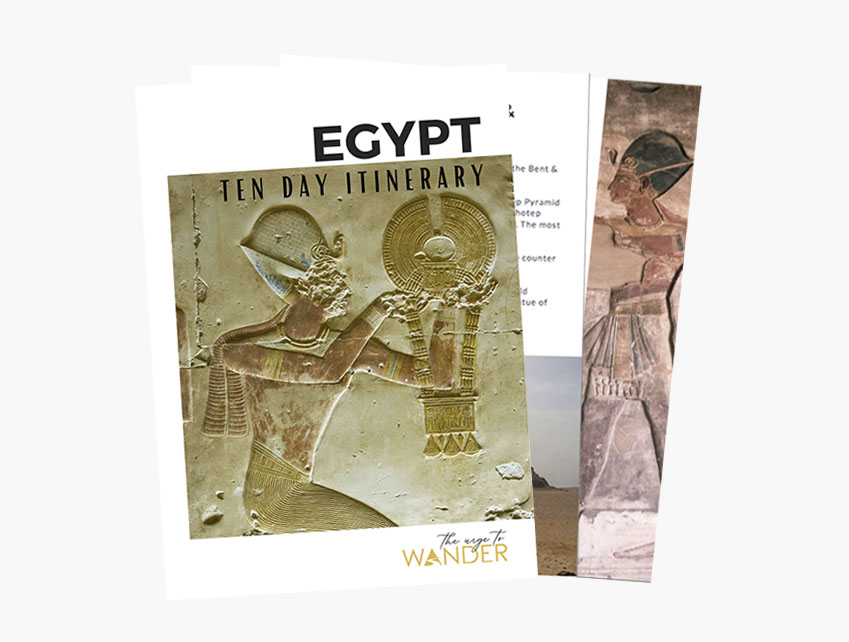
JOIN OVER 20,000 TRAVEL ENTHUSIASTS AND RECEIVE A COMPLIMENTARY COPY OF THE TEN DAY EGYPT ITINERARY PACKED WITH BEAUTIFUL IMAGES AND ALL THE INFORMATION YOU’LL NEED TO PLAN YOUR TRIP
RESOURCES
ENTRANCE TICKETS: Price List of monuments and museums across Egypt.
TOMBS OF EGYPT: In depth presentation of the tombs by Osirisnet.
VIRTUAL TOURS: An amazing series launched by the Egyptian Ministry of Tourism and Antiquities.
EGYPT ON YOUR RADAR? 📌 PIN FOR LATER
DISCLAIMER
DISCLAIMER- The information provided above has been meticulously checked for accuracy at the time of writing and efforts will be made to keep it updated every few months. But things can change without notice so please do corroborate all details with the companies in question/respective websites before finalising your travel plans.
